Post by Stingray on Jul 14, 2008 20:35:47 GMT -4
Mil Mi-10 "Harke"
1960
--------------------------------------------------------------------------------
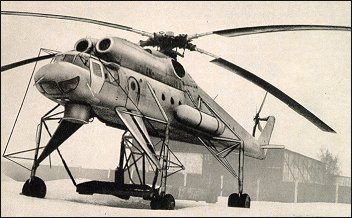
www.aviastar.org/helicopters_eng/mi-10.php
First demonstrated publicly at Tushino in July 1961, the Mi-10 is a flying crane development of the Mi-6, with which it shares a common powerplant and rotor system. The fuselage has been redesigned with a shallower cabin and a deeper tailboom to give a level and flat under-surface against which its various loads can be hoisted. A tall, four-legged, twin-wheel undercarriage is fitted. The aircraft is normally flown by a flight crew of 3 men, and in addition to slung loads can accommodate up to 28 passengers in the cabin boom. Special wheeled platforms have been designed on which the Mi-10's loads can be manoeuvred into position and on which they remain during the airborne journey. Typical loads may include a large passenger coach, a prefabricated building or a large freight pallet. Believed to have flown for the first time in 1960, the Mi-10 is thought to be in service both with the Soviet armed forces and with civil agencies. One is operated in the USA by Petroleum Helicopters Inc, who also have an Mi-8.
In March 1966 the USSR revealed for the first time the Mi-10K, a modified version with a much shorter undercarriage and manned by only 2 crew members, one of whom occupies a rearward-facing gondola underneath the nose from which he can supervise the cargo during loading and in flight. The Mi-10 and Mi-10K obviously have the same application to large scientific or engineering projects as does the Mi-6, though whether they are being produced in the same quantities is open to conjecture. At least one Mi-10K has been seen with a conventional tricycle undercarriage; this may have been the machine which in May 1965 established a new load-to-altitude record by lifting a weight of 25105kg to a height of 2840m. The Soloviev engines which power the Mi-10 and Mi-10K are actually scheduled to reach an output of 3500shp, and when this is realised it will enable the Mi-10K to lift a slung load of 14000kg.
--K.Munson "Helicopters And Other Rotorcraft Since 1907", 1968
The V-10 prototype was a development of the Mi-6 heavylift helicopter, but optimised for the flying-crane role. Retaining basically the same rotor, transmission and powerplant, the V-10 had a slender fuselage more like that of a fixed-wing aircraft and, since it dispensed with the pod-and-boom configuration, appears (falsely) to be much greater in length. Wide-track stalky quadricycle landing gear is provided, so that the helicopter can taxi over a bulky load that is to be carried externally, and because it is intended to be used more extensively in the heavylift role than the Mi-6, it dispenses with the stub wings of this earlier helicopter. First fiown during 1960, the V-10 entered production as the Mil Mi-10, then gaining the NATO reporting name 'Harke', and being superseded in 1964 by a developed version designated Mi-10K which was designed specifically for the carriage of slung loads. The Mi-10K differs from the Mi-10 by having landing gear that is 2.0m shorter, and has a flight deck for one (instead of two) pilots, the second pilot being accommodated in a gondola beneath the nose with an aft-facing seat and with full controls for both helicopter and the load. The main cabin can be used for freight and/or passengers, the latter totalling 28 on somewhat austere tip-up seats. Construction of both versions totalled 55 when production ended in 1971; manufacture was resumed briefly in 1977, but no new production figures have been quoted.
--D.Donald "The Complete Encyclopedia of World Aircraft", 1997
NATO reporting name: Harke
TYPE: Heavy flying crane helicopter.
PROGRAMME: This development of the Mi-6 was demonstrated at the 1961 Soviet Aviation Day display at Tushino, having flown for the first time in the previous year. Above the line of the cabin windows the two helicopters are almost identical, but the depth of the fuselage is reduced considerably on the Mi-10, and the tailboom is deepened so that the flattened undersurface runs unbroken to the tail. The Mi-10 also lacks the fixed wings of the Mi-6.
Items which are interchangeable between the Mi-6 and Mi-10 include the power plant, transmission system and reduction gearboxes, swashplate assembly, main and tail rotors, control system and most items of equipment. The power of the Soloviev turboshaft engines remains constant up to 3,000m and to an ambient temperature of 40°C at sea level. The aircraft will maintain level flight on one engine. Full navigation equipment and an autopilot permit all-weather operation, by day and night.
The tall long-stroke quadricycle landing gear, with wheel track exceeding 6.0m and clearance under the fuselage of 3.75m with the aircraft fully loaded, enables the Mi-10 to taxi over a load it is to carry and to accommodate loads as bulky as a prefabricated building.
Use can be made of interchangeable wheeled cargo platforms which are held in place by hydraulic grips controllable from either the cockpit or a remote panel. Using these grips without a platform, cargoes up to 20m long, 10m wide and 3.1m high can be lifted and secured in 1.5 to 2 minutes. The cabin can accommodate additional freight or passengers.
A closed-circuit TV system, with cameras scanning forward from under the rear fuselage and downward through the sling hatch, is used to observe the payload and main landing gear, touchdown being by this reference. The TV system replaces the retractable undernose 'dustbin' fitted originally.
The following details refer to the standard Mi-10, which has been operated by both Aeroflot and the former Soviet armed forces and is available for export. About 80 believed to have been built. Some have been exported to Iraq and Pakistan.
ROTOR SYSTEM: Same as for Mi-6, except that main rotor shaft is inclined forward at an angle of only 0° 45'.
FUSELAGE: Conventional all-metal riveted semi-monocoque structure.
TAIL UNIT: Same as for Mi-6.
LANDING GEAR: Non-retractable quadricycle type, with twin wheels on each unit. All units fitted with oleo-pneumatic shock-absorbers. Telescopic main legs. Main wheels size 1,230 x 260mm each with brake. Levered-suspension castoring nose units. Nosewheels size 950 x 250mm. All landing gear struts are faired. The port nose gear fairing incorporates steps to the crew door. Despite the height of the gear, the Mi-10 can make stable landing and take-off runs at speeds up to 100km/h.
POWER PLANT: Two 4,101kW Soloviev D-25V turboshaft engines, mounted side by side above cabin, forward of main rotor drive-shaft. Single fuel tank in fuselage and two external tanks on sides of cabin, with total capacity of 6,340kg. Provision for carrying two auxiliary tanks in cabin, to give total fuel capacity of 8,260kg. Engine cowling side panels (opened and closed hydraulically) can be used as maintenance platforms when open.
ACCOMMODATION: Two pilots and flight engineer accommodated on flight deck, which has bulged side windows to provide an improved downward view. Flight deck is heated and ventilated and has provision for oxygen equipment. Crew door is immediately aft of flight deck on port side. Main cabin can be used for freight and/or passengers, 28 tip-up seats being installed along the side walls. Freight is loaded into this cabin through a door on the starboard side, aft of the rear landing gear struts, with the aid of a boom and 200kg capacity electric winch. In addition to the cargo platform described earlier, the Mi-10 has external sling gear as standard equipment. This can be used in conjunction with a winch controlled from a portable control panel inside the cabin. The winch can also be used to raise loads of up to 500kg while the aircraft is hovering on rescue and other duties, via a hatch in the cabin floor. SYSTEMS, AVIONICS AND EQUIPMENT: Generally as for Mi-6, including APU.
--Jane's Helicopter Markets and Systems
It was logical to mate dynamic parts of Mi-6 with rest of helicopter tailored to crane role, lifting bulky external load and positioning over short ranges. Start of design Feb 1958. V-10, prototype of initial Mi-10R version, flown 1960 in VVS markings. This version with dedicated hydraulic locks for securing cargo in space 4m high between four tall legs. Mi-6A dynamic parts, but main rotor axis inclined forwards only 1°30’. New fuselage with shorter nose, different flight deck with no eye brow windows but deep bulged side windows and single door each side well aft (under engine compressors), two pilots and engineer but no nav so no nose compartment. Slim fuselage with cabin 14.04m long, 2.5m wide and 1.68m high for cargo and with 28 tip-up wall seats. Almost straight bottom line; top of rear fuselage slopes down to bring tail fin and rotor much lower than in Mi-6A. Tall quad landing gears with two pairs 1230 x 260mm main tyres and two pairs 950x250mm tyres on castoring nosewheels, with flight-crew steps in left front leg fairing, in some Mi-10s both front legs. Development aircraft had trapeze wires from above flight deck to front wheels for emergency crew escape in low hover. To counter side-thrust at tail and torque effects right legs 300mm shorter than left, crew cabin being canted to keep it laterally level on ground. Fuel in two external pods (3500 litres each) plus internal service tank (731 litres); total 6184kg. Optional ferry tanks in hold, total 2400 litres (1920kg). Provision for pressure-fuelling from ground whilst hovering. Internal cargo loaded via rear right door with 200kg electric hoist. Main load slung externally. Ground clearance 3.75m at full load. Normal procedure to taxi over and straddle load which can measure 20m by 10m (actual Mi-10 track and wheelbase, measured from strut centerlines, 6.92 and 8.29m). Two load-carrying systems: 500-kg winch through floor hatch, and group of four swinging struts picking up corners of load with hydraulic grips controlled from cockpit or remote panel in cabin via TV from two locations. Load can be mounted on special platform 8.53 x 3.54m with or without wheels. AI-8 turbine APU permanently installed for elctric/hydraulic power without main engines. Anticing as Mi-6A. Can make running take-offs and landings at 100km/h. Total Mi-10R about 60. ASCC name ‘Harke’.
--Bill Gunston "The Osprey's Encyclopedia of Russian Aircraft", 2000
* * *
--------------------------------------------------------------------------------
Photo Gallery
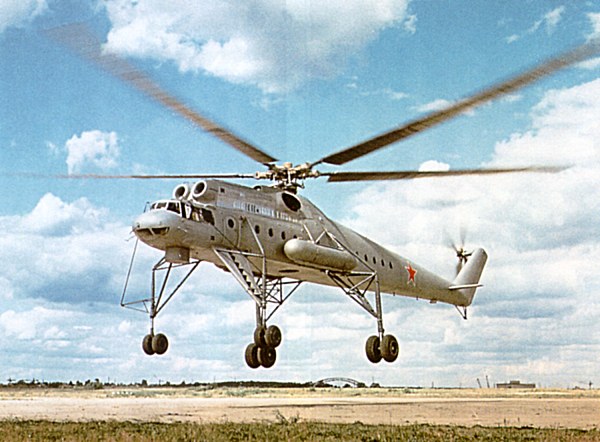
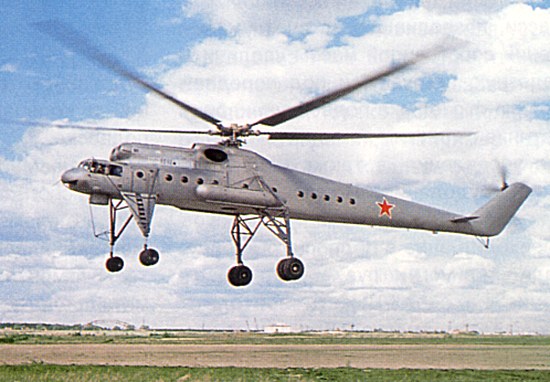
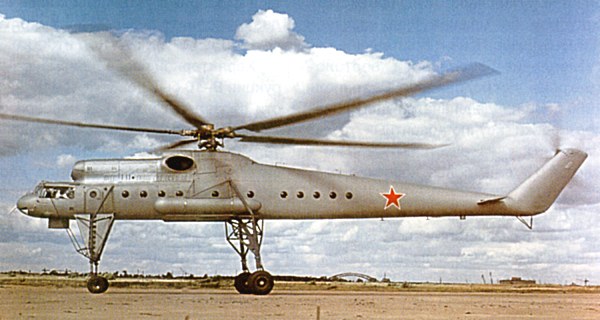
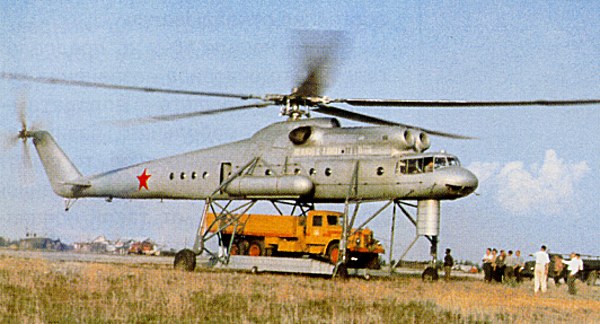
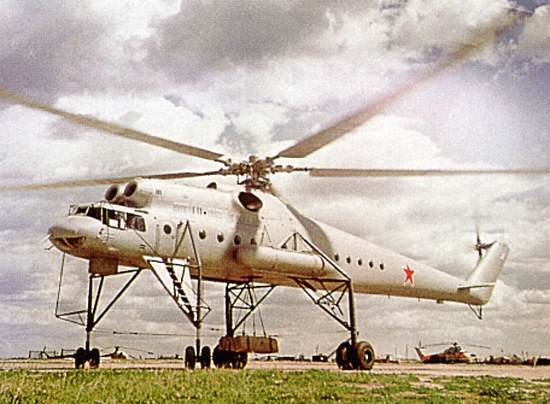
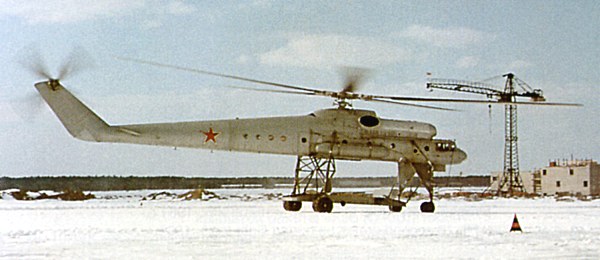
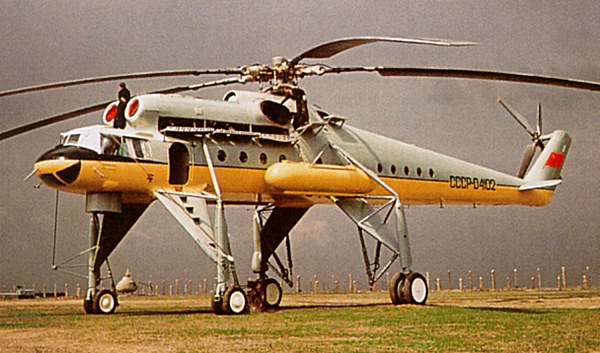
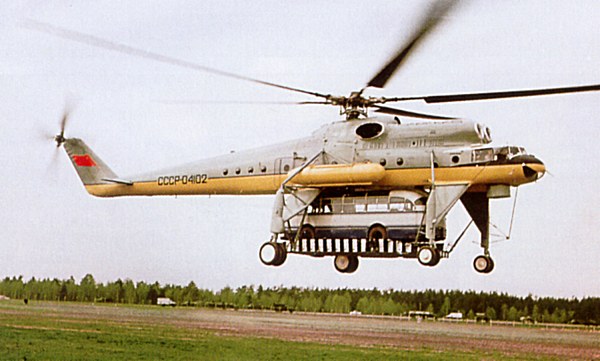
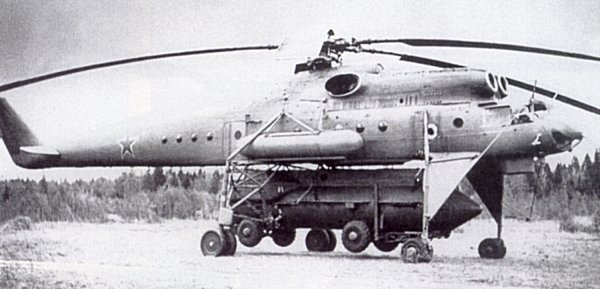
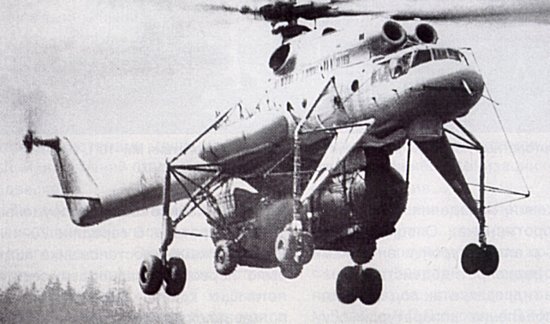
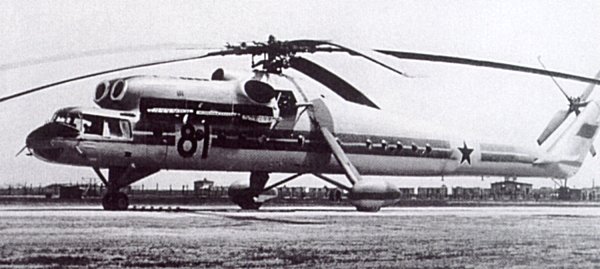
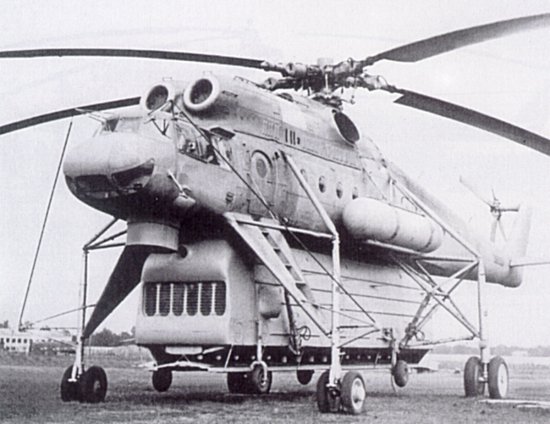
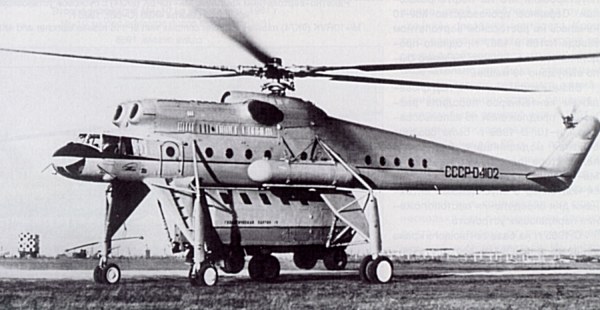
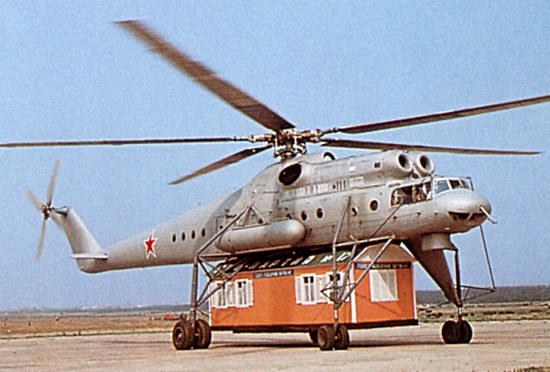
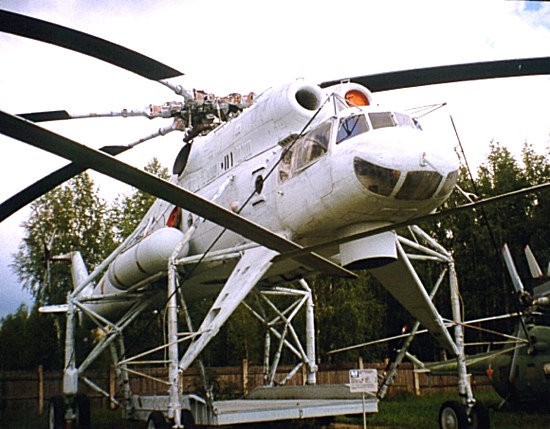
--------------------------------------------------------------------------------
Technical data for Mi-10
Engine: 2 x D-25V turboshaft, rated at 4045kW, main rotor diameter: 35.0m, length without rotors: 32.86m, height: 7.8m, take-off weight: 43450kg, empty weight: 24680kg, max speed: 235km/h, cruising speed: 220km/h, service ceiling: 3000m, range with 8,000kg payload: 420km, payload: 8000-12000kg
--------------------------------------------------------------------------------
Mil Mi-10K
1965
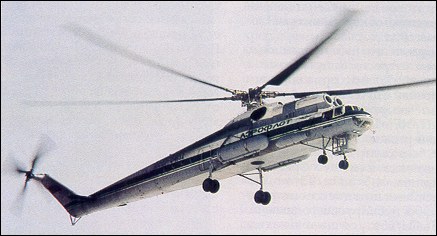
www.aviastar.org/helicopters_eng/mi-10k.php
First displayed publicly in Moscow on 26 March 1966, the Mi-10K is a development of the Mi-10 with a number of important design changes, most apparent of which is a reduction in the height of the landing gear and a more slender tail rotor support structure.
It can be operated by a crew of only two pilots. This is made possible by the provision of an additional cockpit gondola under the front fuselage, with full flying controls and a rearward-facing seat. By occupying this seat, one of the pilots can control the aircraft in hovering flight and, at the same time, have an unrestricted view of cargo loading, unloading and hoisting, which are also under his control.
--Jane's Helicopter Markets and Systems
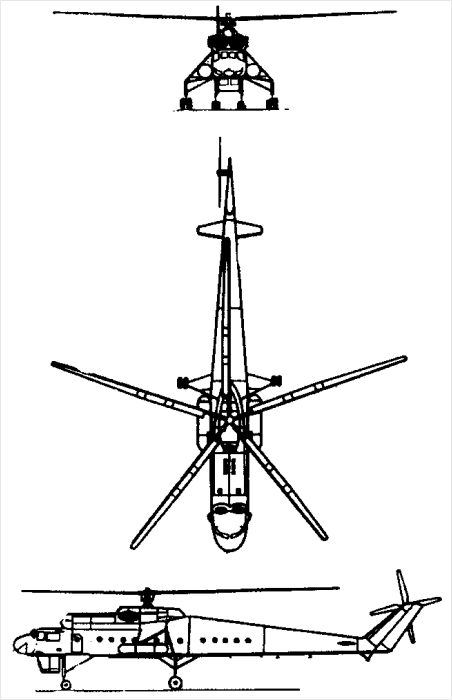
(Korotkonogii, short-legged) presaged by special Mi-10 flown 1965 with single centerline nose gear and single spatted main gears of min length and weight, used to lift 25,105kg to 2840m (G.Alferov, 28 May 1965). This was restored to Mi-10R standard, but in 1966 OKB flew Mi-10K with four short landing gears reducing door sill height from almost 4 to 1.8m. New crew compartment with single pilot at original level and second in central all-glazed gondola facing aft with full controls for helicopter and load. Larger internal fuel cells, giving total with two external tanks of 9000 litres. Tail bumper and much narrower tail fin. Cleared for production October 1966, about 20 built. ASCC ‘Harke’. All versions being grounded Aug 1992.
--Bill Gunston "The Osprey's Encyclopedia of Russian Aircraft", 2000
The final derivative of the Mi-6 is the Mi-10K, seen in public on 26 March 1966. This differs from the Mi-10 in that it has much shorter landing gear and a thinner tail rotor support structure. A glazed gondola is fixed beneath the nose, with a rearward-facing pilot seat. From this position, the occupant can control the helicopter during hovering and superintend loading and un-loading. The maximum payload is 11000kg, but this can be increased to 14000kg by installing Soloviev D-25VF engines, each of which yield 6500shp.
--G.Apostolo "The Illustrated Encyclopedia of Helicopters", 1984
--------------------------------------------------------------------------------
Photo Gallery
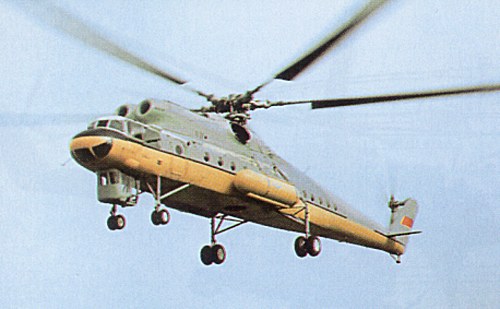
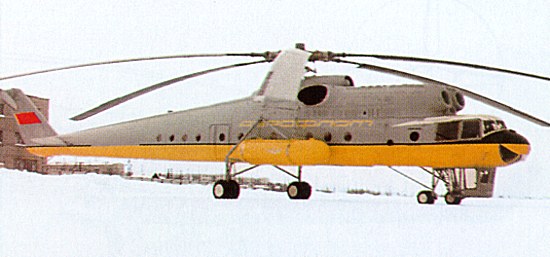
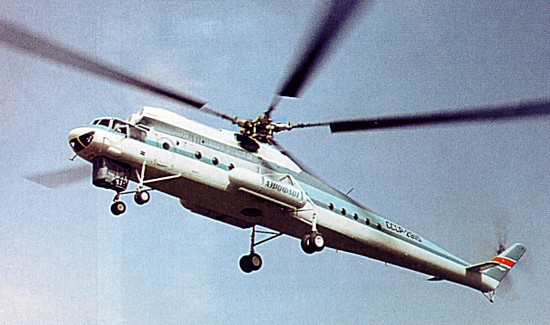
--------------------------------------------------------------------------------
Technical data for Mi-10K
Engine: 2 x Solovyov D-25V turboshaft, rated at 4101kW, main rotor diameter: 35.0m, length with rotors turning: 41.89m, height: 7.8m, take-off weight with payload on a sling: 38000kg, empty weight: 24680kg, max speed with payload on a sling: 202km/h, ceiling: 3000m, range with typical payload: 250km, max payload: 11000kg
1960
--------------------------------------------------------------------------------

www.aviastar.org/helicopters_eng/mi-10.php
First demonstrated publicly at Tushino in July 1961, the Mi-10 is a flying crane development of the Mi-6, with which it shares a common powerplant and rotor system. The fuselage has been redesigned with a shallower cabin and a deeper tailboom to give a level and flat under-surface against which its various loads can be hoisted. A tall, four-legged, twin-wheel undercarriage is fitted. The aircraft is normally flown by a flight crew of 3 men, and in addition to slung loads can accommodate up to 28 passengers in the cabin boom. Special wheeled platforms have been designed on which the Mi-10's loads can be manoeuvred into position and on which they remain during the airborne journey. Typical loads may include a large passenger coach, a prefabricated building or a large freight pallet. Believed to have flown for the first time in 1960, the Mi-10 is thought to be in service both with the Soviet armed forces and with civil agencies. One is operated in the USA by Petroleum Helicopters Inc, who also have an Mi-8.
In March 1966 the USSR revealed for the first time the Mi-10K, a modified version with a much shorter undercarriage and manned by only 2 crew members, one of whom occupies a rearward-facing gondola underneath the nose from which he can supervise the cargo during loading and in flight. The Mi-10 and Mi-10K obviously have the same application to large scientific or engineering projects as does the Mi-6, though whether they are being produced in the same quantities is open to conjecture. At least one Mi-10K has been seen with a conventional tricycle undercarriage; this may have been the machine which in May 1965 established a new load-to-altitude record by lifting a weight of 25105kg to a height of 2840m. The Soloviev engines which power the Mi-10 and Mi-10K are actually scheduled to reach an output of 3500shp, and when this is realised it will enable the Mi-10K to lift a slung load of 14000kg.
--K.Munson "Helicopters And Other Rotorcraft Since 1907", 1968
The V-10 prototype was a development of the Mi-6 heavylift helicopter, but optimised for the flying-crane role. Retaining basically the same rotor, transmission and powerplant, the V-10 had a slender fuselage more like that of a fixed-wing aircraft and, since it dispensed with the pod-and-boom configuration, appears (falsely) to be much greater in length. Wide-track stalky quadricycle landing gear is provided, so that the helicopter can taxi over a bulky load that is to be carried externally, and because it is intended to be used more extensively in the heavylift role than the Mi-6, it dispenses with the stub wings of this earlier helicopter. First fiown during 1960, the V-10 entered production as the Mil Mi-10, then gaining the NATO reporting name 'Harke', and being superseded in 1964 by a developed version designated Mi-10K which was designed specifically for the carriage of slung loads. The Mi-10K differs from the Mi-10 by having landing gear that is 2.0m shorter, and has a flight deck for one (instead of two) pilots, the second pilot being accommodated in a gondola beneath the nose with an aft-facing seat and with full controls for both helicopter and the load. The main cabin can be used for freight and/or passengers, the latter totalling 28 on somewhat austere tip-up seats. Construction of both versions totalled 55 when production ended in 1971; manufacture was resumed briefly in 1977, but no new production figures have been quoted.
--D.Donald "The Complete Encyclopedia of World Aircraft", 1997
NATO reporting name: Harke
TYPE: Heavy flying crane helicopter.
PROGRAMME: This development of the Mi-6 was demonstrated at the 1961 Soviet Aviation Day display at Tushino, having flown for the first time in the previous year. Above the line of the cabin windows the two helicopters are almost identical, but the depth of the fuselage is reduced considerably on the Mi-10, and the tailboom is deepened so that the flattened undersurface runs unbroken to the tail. The Mi-10 also lacks the fixed wings of the Mi-6.
Items which are interchangeable between the Mi-6 and Mi-10 include the power plant, transmission system and reduction gearboxes, swashplate assembly, main and tail rotors, control system and most items of equipment. The power of the Soloviev turboshaft engines remains constant up to 3,000m and to an ambient temperature of 40°C at sea level. The aircraft will maintain level flight on one engine. Full navigation equipment and an autopilot permit all-weather operation, by day and night.
The tall long-stroke quadricycle landing gear, with wheel track exceeding 6.0m and clearance under the fuselage of 3.75m with the aircraft fully loaded, enables the Mi-10 to taxi over a load it is to carry and to accommodate loads as bulky as a prefabricated building.
Use can be made of interchangeable wheeled cargo platforms which are held in place by hydraulic grips controllable from either the cockpit or a remote panel. Using these grips without a platform, cargoes up to 20m long, 10m wide and 3.1m high can be lifted and secured in 1.5 to 2 minutes. The cabin can accommodate additional freight or passengers.
A closed-circuit TV system, with cameras scanning forward from under the rear fuselage and downward through the sling hatch, is used to observe the payload and main landing gear, touchdown being by this reference. The TV system replaces the retractable undernose 'dustbin' fitted originally.
The following details refer to the standard Mi-10, which has been operated by both Aeroflot and the former Soviet armed forces and is available for export. About 80 believed to have been built. Some have been exported to Iraq and Pakistan.
ROTOR SYSTEM: Same as for Mi-6, except that main rotor shaft is inclined forward at an angle of only 0° 45'.
FUSELAGE: Conventional all-metal riveted semi-monocoque structure.
TAIL UNIT: Same as for Mi-6.
LANDING GEAR: Non-retractable quadricycle type, with twin wheels on each unit. All units fitted with oleo-pneumatic shock-absorbers. Telescopic main legs. Main wheels size 1,230 x 260mm each with brake. Levered-suspension castoring nose units. Nosewheels size 950 x 250mm. All landing gear struts are faired. The port nose gear fairing incorporates steps to the crew door. Despite the height of the gear, the Mi-10 can make stable landing and take-off runs at speeds up to 100km/h.
POWER PLANT: Two 4,101kW Soloviev D-25V turboshaft engines, mounted side by side above cabin, forward of main rotor drive-shaft. Single fuel tank in fuselage and two external tanks on sides of cabin, with total capacity of 6,340kg. Provision for carrying two auxiliary tanks in cabin, to give total fuel capacity of 8,260kg. Engine cowling side panels (opened and closed hydraulically) can be used as maintenance platforms when open.
ACCOMMODATION: Two pilots and flight engineer accommodated on flight deck, which has bulged side windows to provide an improved downward view. Flight deck is heated and ventilated and has provision for oxygen equipment. Crew door is immediately aft of flight deck on port side. Main cabin can be used for freight and/or passengers, 28 tip-up seats being installed along the side walls. Freight is loaded into this cabin through a door on the starboard side, aft of the rear landing gear struts, with the aid of a boom and 200kg capacity electric winch. In addition to the cargo platform described earlier, the Mi-10 has external sling gear as standard equipment. This can be used in conjunction with a winch controlled from a portable control panel inside the cabin. The winch can also be used to raise loads of up to 500kg while the aircraft is hovering on rescue and other duties, via a hatch in the cabin floor. SYSTEMS, AVIONICS AND EQUIPMENT: Generally as for Mi-6, including APU.
--Jane's Helicopter Markets and Systems
It was logical to mate dynamic parts of Mi-6 with rest of helicopter tailored to crane role, lifting bulky external load and positioning over short ranges. Start of design Feb 1958. V-10, prototype of initial Mi-10R version, flown 1960 in VVS markings. This version with dedicated hydraulic locks for securing cargo in space 4m high between four tall legs. Mi-6A dynamic parts, but main rotor axis inclined forwards only 1°30’. New fuselage with shorter nose, different flight deck with no eye brow windows but deep bulged side windows and single door each side well aft (under engine compressors), two pilots and engineer but no nav so no nose compartment. Slim fuselage with cabin 14.04m long, 2.5m wide and 1.68m high for cargo and with 28 tip-up wall seats. Almost straight bottom line; top of rear fuselage slopes down to bring tail fin and rotor much lower than in Mi-6A. Tall quad landing gears with two pairs 1230 x 260mm main tyres and two pairs 950x250mm tyres on castoring nosewheels, with flight-crew steps in left front leg fairing, in some Mi-10s both front legs. Development aircraft had trapeze wires from above flight deck to front wheels for emergency crew escape in low hover. To counter side-thrust at tail and torque effects right legs 300mm shorter than left, crew cabin being canted to keep it laterally level on ground. Fuel in two external pods (3500 litres each) plus internal service tank (731 litres); total 6184kg. Optional ferry tanks in hold, total 2400 litres (1920kg). Provision for pressure-fuelling from ground whilst hovering. Internal cargo loaded via rear right door with 200kg electric hoist. Main load slung externally. Ground clearance 3.75m at full load. Normal procedure to taxi over and straddle load which can measure 20m by 10m (actual Mi-10 track and wheelbase, measured from strut centerlines, 6.92 and 8.29m). Two load-carrying systems: 500-kg winch through floor hatch, and group of four swinging struts picking up corners of load with hydraulic grips controlled from cockpit or remote panel in cabin via TV from two locations. Load can be mounted on special platform 8.53 x 3.54m with or without wheels. AI-8 turbine APU permanently installed for elctric/hydraulic power without main engines. Anticing as Mi-6A. Can make running take-offs and landings at 100km/h. Total Mi-10R about 60. ASCC name ‘Harke’.
--Bill Gunston "The Osprey's Encyclopedia of Russian Aircraft", 2000
* * *
--------------------------------------------------------------------------------
Photo Gallery















--------------------------------------------------------------------------------
Technical data for Mi-10
Engine: 2 x D-25V turboshaft, rated at 4045kW, main rotor diameter: 35.0m, length without rotors: 32.86m, height: 7.8m, take-off weight: 43450kg, empty weight: 24680kg, max speed: 235km/h, cruising speed: 220km/h, service ceiling: 3000m, range with 8,000kg payload: 420km, payload: 8000-12000kg
--------------------------------------------------------------------------------
Mil Mi-10K
1965

www.aviastar.org/helicopters_eng/mi-10k.php
First displayed publicly in Moscow on 26 March 1966, the Mi-10K is a development of the Mi-10 with a number of important design changes, most apparent of which is a reduction in the height of the landing gear and a more slender tail rotor support structure.
It can be operated by a crew of only two pilots. This is made possible by the provision of an additional cockpit gondola under the front fuselage, with full flying controls and a rearward-facing seat. By occupying this seat, one of the pilots can control the aircraft in hovering flight and, at the same time, have an unrestricted view of cargo loading, unloading and hoisting, which are also under his control.
--Jane's Helicopter Markets and Systems

(Korotkonogii, short-legged) presaged by special Mi-10 flown 1965 with single centerline nose gear and single spatted main gears of min length and weight, used to lift 25,105kg to 2840m (G.Alferov, 28 May 1965). This was restored to Mi-10R standard, but in 1966 OKB flew Mi-10K with four short landing gears reducing door sill height from almost 4 to 1.8m. New crew compartment with single pilot at original level and second in central all-glazed gondola facing aft with full controls for helicopter and load. Larger internal fuel cells, giving total with two external tanks of 9000 litres. Tail bumper and much narrower tail fin. Cleared for production October 1966, about 20 built. ASCC ‘Harke’. All versions being grounded Aug 1992.
--Bill Gunston "The Osprey's Encyclopedia of Russian Aircraft", 2000
The final derivative of the Mi-6 is the Mi-10K, seen in public on 26 March 1966. This differs from the Mi-10 in that it has much shorter landing gear and a thinner tail rotor support structure. A glazed gondola is fixed beneath the nose, with a rearward-facing pilot seat. From this position, the occupant can control the helicopter during hovering and superintend loading and un-loading. The maximum payload is 11000kg, but this can be increased to 14000kg by installing Soloviev D-25VF engines, each of which yield 6500shp.
--G.Apostolo "The Illustrated Encyclopedia of Helicopters", 1984
--------------------------------------------------------------------------------
Photo Gallery



--------------------------------------------------------------------------------
Technical data for Mi-10K
Engine: 2 x Solovyov D-25V turboshaft, rated at 4101kW, main rotor diameter: 35.0m, length with rotors turning: 41.89m, height: 7.8m, take-off weight with payload on a sling: 38000kg, empty weight: 24680kg, max speed with payload on a sling: 202km/h, ceiling: 3000m, range with typical payload: 250km, max payload: 11000kg





